Chapter 6, Section B Reading
1/30
There's no tags or description
Looks like no tags are added yet.
Name | Mastery | Learn | Test | Matching | Spaced |
|---|
No study sessions yet.
31 Terms
When is ballast used, and what’s the difference between permanent and temporary ballast?
Ballast may be required to bring an aircraft into the desired CG range.
Permanent ballast is weight that is never removed from the aircraft.
Temporary ballast is installed only to bring the CG within its range for a specific flight condition.
What are the variables in the weight-shift formula, and how is it written?
The formula has four variables: weight shifted, total weight, CG change required, and distance weight is shifted. It is written as:
weight shifted = (total weight × CG change required) / distance weight is shifted.
If you know any three, you can solve for the fourth.
How do you check for an adverse-loading condition? (List 3)
Compute three checks:
A forward adverse-loading check
A rearward adverse-loading check,
A maximum gross weight check.
Definition of permanent ballast
A weight that has been permanently installed in an aircraft to bring its center of gravity into allowable limits.
Definition of temporary ballast
Weight installed in an aircraft to bring it into the CG range for a specific flight condition.
Definition of forward adverse-loading check
A weight and balance computation performed with the aircraft loaded in the most forward adverse loading condition to determine whether the aircraft can be loaded outside of the CG range.
Definition of rearward adverse-loading check
A weight and balance computation performed with the aircraft loaded in the most rearward adverse loading condition to determine whether it can be loaded outside of the CG range.
Definition of maximum gross weight check
A weight computation to determine whether it is possible to load the aircraft in a manner that can exceed the gross weight of the aircraft.
1. Weight that is installed in an aircraft for the purpose of bringing the CG into the desired range is called ______.
ballast
2. What formula is used to compute the weight of ballast needed?
Ballast = _______________________________

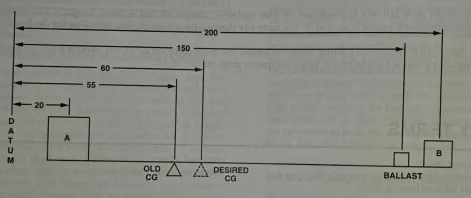
3. Given information:
Weight A = 200 pounds Datum to A = 20 inches
Weight B = 40.3 pounds Datum to B = 200 inches
Datum to old CG = 55 inches
Datum to desired CG = 60 inches
Datum to ballast location = 190 inches
Find:
Weight of ballast needed to move the center of gravity from 55 inches to 60 inches from the datum = ______ pounds
9.55 lbs
4. Using the Type Certificate Data Sheet for the Beech model 60 (pages 6-8 through 6-10 of the text), find the following information:
a. Datum location = ____________________________
b. Maximum weight = ___________________________
a. 100 inches forward of the front pressure bulkhead
b. 6,725 pounds
5. When weighing an aircraft the hydraulic reservoir should be ______ (full or empty).
full
6. Fuel tanks should be ______ (full or empty), if possible, when weighing an aircraft.
empty
7. The weight of any ______ used to hold the aircraft on the scales must be subtracted from the scale readings.
tare
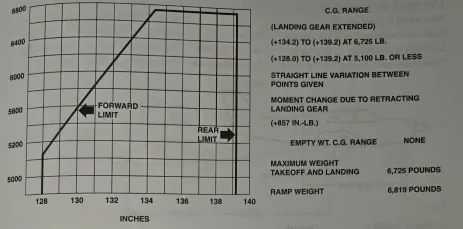
8. Find the following CG limits, using this graph.
a. Forward CG limit at 5,100 pounds = ______ inches.
b. Rear CG limit at 5,100 pounds = ______ inches.
c. Forward CG limit at 6,400 pounds = ______ inches.
d. Rear CG limit at maximum takeoff weight = ______ inches.
a. 128
b. 139.2
c. 133
d. 139.2
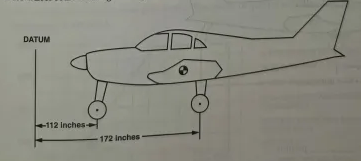
9. Given information:
Distance datum to nose wheel = 112 inches
Distance datum to main wheels = 172 inches
Right main scale reading = 412 pounds tare = 16 pounds
Left main scale reading = 406 pounds tare = 16 pounds
Nose wheel scale reading = 260 pounds no tare
Find:
a. The empty weight = ______ pounds
b. The empty weight center of gravity is ______ inch(es) behind the datum.
a. 1,046
b. 157.09
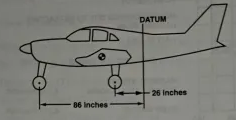
10. Given information:
Main wheels are at station –26
Nose wheel is at station –86
Right main scale reading = 396 pounds no tare
Left main scale reading = 395 pounds tare = 5 pounds
Nose wheel scale reading = 270 pounds no tare
Find:
a. Empty weight = ______ pounds
b. Empty weight center of gravity is at station ______.
a. 1,046
b. –40.91
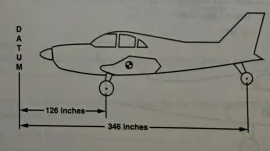
11. Given information:
Main wheels are located at station 126
Tail wheel is located at station 346
Right main scale reading = 427 pounds tare = 7 pounds
Left main scale reading = 424 pounds tare = 7 pounds
Tailwheel scale reading = 173 pounds tare = 10 pounds
Find:
a. Empty weight = ______ pounds
b. Empty weight center of gravity is at station ______.
a. 1,000
b. 161.86

12. Given information:
Main wheels are 140 inches ahead of the datum
Tail wheel is 80 inches behind the datum
Right main scale reading = 403 pounds no tare
Left main scale reading = 417 pounds no tare
Tail wheel scale reading = 180 pounds no tare
Find:
a. Empty weight = ______ pounds
b. Empty weight center of gravity is ______ inch(es) ______ (ahead of or behind) the datum.
a. 1,000
b. 100.4 ahead
13. MAC is an abbreviation for ______ and is used on some aircraft to locate the center of gravity range.
Mean Aerodynamic Chord
14. If a wing has a mean aerodynamic chord of 120 inches and the LEMAC is located at station 126, what is the CG range, in inches from the datum, if the forward limit is at 27% MAC and the rear limit is at 34% MAC?
Forward limit = station ______
Rear limit = station ______
Forward limit = 158.4
Rear limit = 166.8
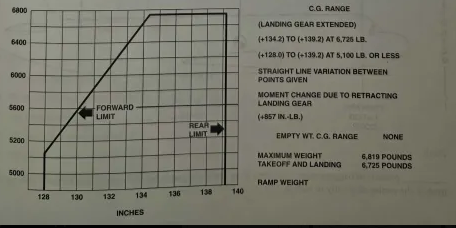
15. The airplane whose center of gravity graph is given here has its center of gravity at 132 inches at a weight of 5,800 pounds with the landing gear down. The center of gravity will move to ______ inches when the landing gear is retracted.
132.147
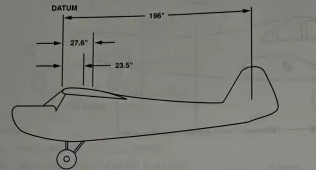
16. Given information:
Empty weight of airplane = 926 pounds
Empty weight center of gravity range = +23.5 to +27.6
Empty weight center of gravity = +21.4
Distance – datum to tailpost = 196 inches
Find:
It will require ______ pounds of fixed ballast on the tailpost to move the empty weight center of gravity to +23.5.
11.27
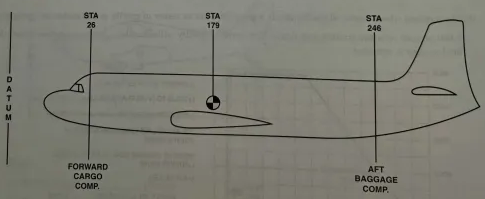
17. Given information:
Airplane loaded weight = 7,600 pounds
Airplane loaded center of gravity = station 179
Find:
______ pounds of baggage must be shifted from the aft baggage compartment to the forward compartment to shift the center of gravity to station 175.
138.18
18. When computing the maximum forward loaded CG of an aircraft, minimum weights, arms, and moments should be used for items of useful load that are located aft of the ______ (forward or rear) CG limit.
forward
19. An approximation of minimum fuel required for adverse loading checks can be obtained by dividing the METO horsepower by ______ to get the number of pounds required.
2
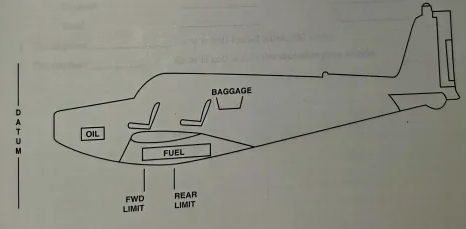
20. Given information:
Oil = 12 quarts at +26
Fuel = 56 gallons at +60
Front seats = 2 at +51
Rear seats = 2 at +73
Baggage = 140 pounds at +83
Center of gravity limits = +51 to +58
Airplane empty weight = 2,016 pounds at +53.2
Engine = 260 METO horsepower
Maximum allowable gross weight = 3,200 pounds
Find:
a. Forward loaded weight = ______ pounds
b. Forward loaded center of gravity = ______
c. Aft loaded weight = ______ pounds
d. Aft loaded center of gravity = ______
e. Maximum loaded weight = ______
f. Maximum loaded center of gravity = ______
a. 2,338.5
b. 53.16
c. 3,024.5
d. 57.23
e. 3,194.5
f. 56.90
21. Given information:
Aircraft empty weight = 1,800 pounds
Empty weight center of gravity = +31.5 inches
Work accomplished:
Removed two 15-pound seats from +72.0
Structural modification added 14 pounds at +76
Installed seat weighing 20 pounds at +73.5
Installed radio weighing 30 pounds at +30
Find:
a. The new empty weight is _______________.
b. The new empty weight center of gravity is _______________.
a. 1,834
b. +31.61
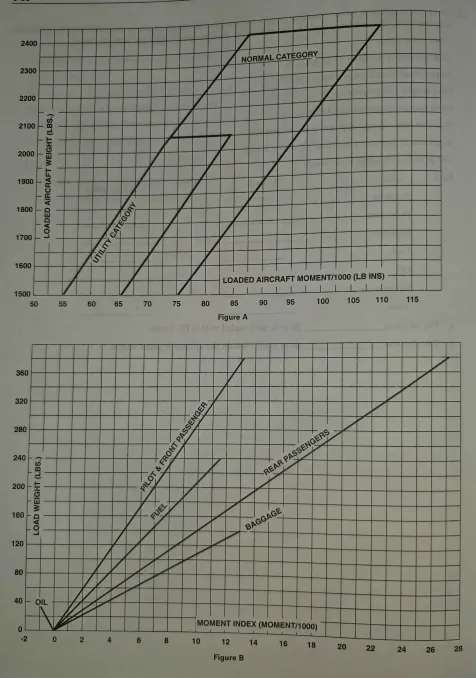
22. Using the weight and balance loading graphs and moment envelope charts in Figures A and B, determine whether or not this airplane would be loaded within its allowable weight and balance limits.
Given information:
Airplane empty weight = 1,312 pounds
Empty weight center of gravity = +37.6
Pilot weighs 190 pounds
Front seat passenger weighs 180 pounds
Rear seat passengers weigh 106 and 132 pounds
36 gallons of fuel and 8 quarts of oil are on board
100 pounds of baggage is on board
Find:
Item | Weight | Moment index
Airplane | ______ | ______
Front seat | ______ | ______
Rear seat | ______ | ______
Fuel | ______ | ______
Oil | ______ | ______
Baggage | ______ | ______
Total | ______ | ______
a. The airplane ______ (is or is not) loaded within CG limits.
b. The airplane ______ (is or is not) within the allowable gross weight.
Airplane – 1,312 – 49.33
Front seat – 370 – 12.70
Rear seat – 238 – 17.00
Fuel – 216 – 10.50
Oil – 15 – - 0.5
Baggage – 100 – 9.20
Total – 2,251 – 98.23
a. is
b. is

23. Using the information provided here and in Figures C and D, find the takeoff weight and takeoff index.
a. Takeoff weight = ______
b. Takeoff index = ______
c. This airplane ______ (is or is not) loaded within its allowable takeoff gross weight.
d. The index ______ (is or is not) within the allowable limits.

a. 9,000
b. 8,491
c. is
d. is